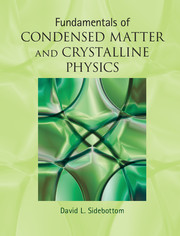 Fundamentals of Condensed Matter and Crystalline Physics
Fundamentals of Condensed Matter and Crystalline Physics from Part III - Dynamics
Published online by Cambridge University Press: 05 August 2012
Introduction
In the last chapter, we took a brash and somewhat unrealistic approach to treating the motion of electrons in a crystal. Although we know that the electron travels through a periodic potential caused by the regular arrangement of ion cores, we disregarded this “bumpy terrain” and considered instead only the barest consequences of the electron being trapped in the crystal “box” as a whole. In spite of its simplicity, this free electron model provided insightful explanations, not only for the origin of the small electronic contribution to specific heat and the temperature dependence of the electrical resistivity, but also for a host of emission phenomena, including the photoelectric effect.
However, the free electron model fails to provide any insight into additional questions regarding electrical conduction, such as (1) the anomaly of positive Hall coefficients that would imply positive charge carriers, and (2) the peculiar pattern of conductors, insulators and semiconductors that is found in the periodic table. In this chapter, we examine the nearly free electron model as a natural extension in which a weak, periodic potential is introduced. As a direct consequence of this addition, the continuum of electron energies in our free electron model now becomes separated into bands of allowed electron energy, separated by disallowed energy gaps. This separation of the electron energy into bands and gaps is key to understanding the division of materials into conductors, insulators and semiconductors, as well as providing a natural interpretation for the positive Hall coefficients.
To save this book to your Kindle, first ensure [email protected] is added to your Approved Personal Document E-mail List under your Personal Document Settings on the Manage Your Content and Devices page of your Amazon account. Then enter the ‘name’ part of your Kindle email address below. Find out more about saving to your Kindle.
Note you can select to save to either the @free.kindle.com or @kindle.com variations. ‘@free.kindle.com’ emails are free but can only be saved to your device when it is connected to wi-fi. ‘@kindle.com’ emails can be delivered even when you are not connected to wi-fi, but note that service fees apply.
Find out more about the Kindle Personal Document Service.
To save content items to your account, please confirm that you agree to abide by our usage policies. If this is the first time you use this feature, you will be asked to authorise Cambridge Core to connect with your account. Find out more about saving content to Dropbox.
To save content items to your account, please confirm that you agree to abide by our usage policies. If this is the first time you use this feature, you will be asked to authorise Cambridge Core to connect with your account. Find out more about saving content to Google Drive.